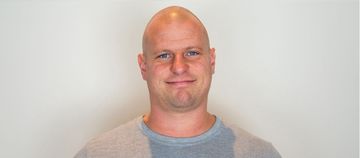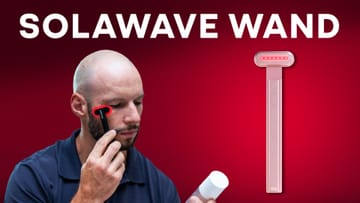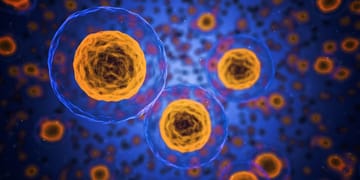So I just got back from PBM 2024 in London. The topic - as the name already implies, is "photobiomodulation", better known as "red light therapy", in 2024.
Many different scientists and companies related to the red light therapy space came to this event, giving ample opportunity to network with people, listen to academic presentations, view and try new products, and so forth!
The event was terrific and I'll do a review and writeup of my most important lessons in this blog post. The event was held at the Park Plaza Westminster Bridge Hotel, where me and my team members also stayed. According to the event hosts, this one was the biggest yet, with the most significant number of people attending.
I was there, Alex Fergus was there, and our excellent executive assistant Lisa Saitz also joined. Alex carried out tons of interviews during the event, which will be published on our YouTube channel soon. I mostly focused on participating a lot in the science lectures, and I've reported on these quite heavily.
Here you can see our team from Light Therapy Insiders before the black-tie gala on Saturday evening, the second day of the event:
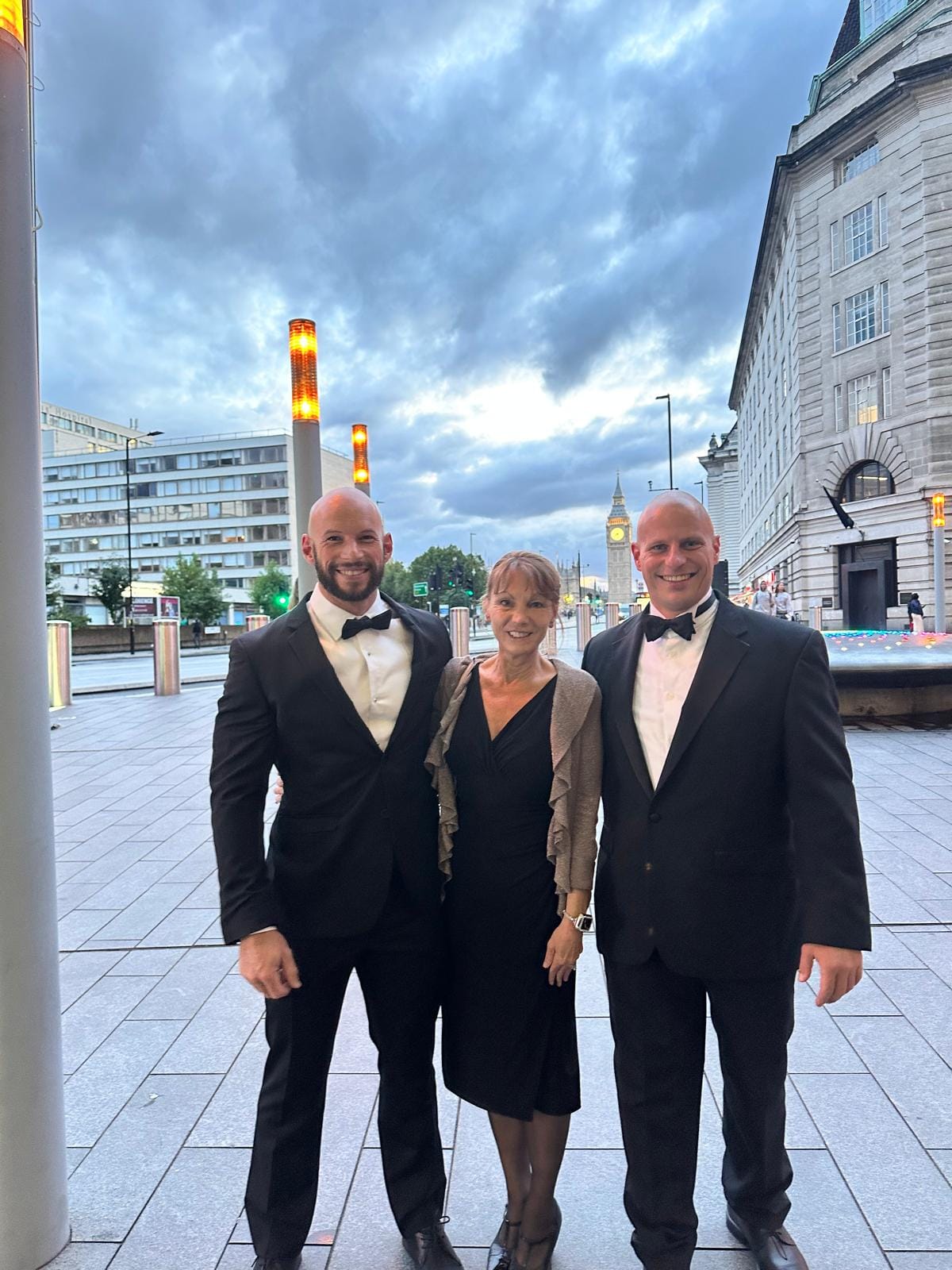
That's Alex Fergus, Lisa Saitz (who also made some wonderful pictures in this blog!), and me! So let's learn what lessons I've got from PBM 2024:
1) Upgrading Dental Work With Prof. Dr. Reem Hanna
Red light therapy for dental work - or "Photobiomodulation" for dentistry - is still a topic I must venture into. So I was extremely happy to see Prof. Dr. Reem Hanna present decades of her experience in this field.
Prof. Hanna also presented lots of case studies with her patients, that I unfortunately couldn't photograph nor copy due to privacy concerns. But these case studies made the science on this topic come alive.
The topic here wasn't just dentistry but also "orofacial disorders" (1; 2; 3; 4). Orofacial disorders are problems with the jaw, lips, facial muscles, tongue, and so forth - any tissue near your teeth - that can also be dysfunctional. Problems in these areas can mutually reinforce each other. For instance, you may start mouth breathing due to jaw problems and a poor airway structure, which causes teeth problems down the road.
There are many lymph nodes around the human ear, below the jaw, and even in the lower jaw. So, if that lymphatic system isn't working properly, detoxification from the brain is going to be impacted.
And, this is my interpretation, not Prof Dr Hanna's - if your tooth structure doesn't allow for proper movement and position of the tongue, then the lymphatic system in relation to the brain and face is going to be affected, and thereby your overall body's detox.
Also, Reem Hanna's speech wasn't just about photobiomodulation but also about Photodynamic Therapy (PBT). In PBT, you use a substance that interacts with light. That substance-light interaction then changes the entire dynamic of the treatment.
Hanna also gave an excellent introduction to the physics and biological mechanisms of photobiomodulation - as did most other speakers at the conference.
One exciting argument Prof Dr Reem Hanna made is that with LED clusters - so multiple LEDs, you can get penetration similar to lasers. Generally, though, lasers will have higher penetration, according to Hanna, because of the better beam angle. The light from a laser points straight ahead, while LEDs project some of its light outward.
Prof Dr Reem Hanna also thinks the contact method has superior penetration for both lasers and LEDs. And, if you apply pressure with the contact method, so if you push a handheld panel into the skin, the penetration will be even greater.
I wasn't aware of the latter dynamic myself yet. But it's very interesting as it can have implications for how to use devices.
For dosing, Hanna seems to follow common sense. Her slides showed 1-10 J/cm2 for superficial tissues and 10-50 J/cm2 for deeper tissues. High pain, deep tissue, in her slides, show a dose of 10-185 J/cm2.
So next up, let's consider where photobiomodulation for dentistry can be used for. I'm quoting these domains from Prof Dr Hanna's slides. First up, for bone regeneration:
- Accelerates tooth movement [comment Bart: when you re-align the teeth with orthodontics, red light therapy can speed up the movement of the teeth here as well as healing]
- MRONJ [comment Bart: "Medication-Related Osteonecrosis Of The Jaw" - whereby medication causes bone loss in the jaw]
- Bone-implant contact
- Large bony defects
- Post-removal of jaw cysts
- Chronic periodontitis [comment Bart: gum inflammation]
- Extraction socket preservation [comment Bart: if a tooth is extracted, the socket can get inflamed and cause jaw defects if untreated]
Then there are benefits in the area of wound healing:
- Oral mucositis [comment Bart: this is a health condition arising as a side effect of cancer treatment. Red light therapy has an excellent profile here (4; 5; 6).
- Aphthous ulcerations [comment Bart: ulcers in the mouth]
- Dental traumatology
- Oral surgical wounds
- Herpes Simplex type I
- Mucogingival surgery
- Oral mucosal lesions
- Facial paralysis
Finally, there's pain management:
- Tooth movement/orthodontic separators
- Post-surgical endodontic Rx [comment Bart: if the pulp inside the tooth has been treated - the pulp is located below the enamel and dentin layers.]
- Temporomandibular dysfunction syndrome [comment Bart: your jaw joint that allows your lower jaw to move]
- Neuropathic pain
- Nerve injury
- Herpes simplex type I
- Post-surgical extraction
- Trigeminal neuralgia [comment Bart: the trigeminal nerve is nerve III, which directly stems from the brain and can cause over-the-top hellish pain for patients that I still remember from when I was a physiotherapist. Fortunately, now the underlying mechanisms are better understood than 15 years ago when I was with patients, as there seems to be a vascular compression problem that's treatable with PBM!]
(Again, I've directly quoted these applications from Prof Dr Reem Hanna's sheets so all credit goes to her!)
The presentation went a lot deeper into topics such as bone remodeling and pain management and when to choose for photobiomodulation or to refer a patient to another medical practitioner.
I could go into much more detail here, but the overall picture should be clear! There are tons and tons of applications of photobiomodulation for dentistry - and I'll probably do a deep dive into the research and write some articles on these topics soon!
As Prof Dr Reem Hanna is also the chair of the PBM 2024 conference, I want to thank her for the beautiful time in London and I hope to see her again in 2026!
Nevertheless, the number of human studies supporting photobiomodulation for dental work is growing rapidly. So I'll expect a lot more applications here down the road!
2) The History Of Photobiomodulation Is Fascinating - What Was True Back Then Is True Today!
PBM 2024 was co-hosted by "WALT". WALT stands for the World Association for Photobiomodulation Therapy. The letters don't perfectly align because the names of the therapy have been changed over time.
In the past, photobiomodulation was called "Low-Level Laser Therapy" (LLLT), for instance, but with the advent of LEDs for therapeutics, LLLT no longer conveyed the meaning perfectly.
The pioneering studies of what we call photobiomodulation today occurred in the 1960s and 70s. The industry has come a long way since then, but some of the topics that were heavily discussed back then still are today.
Prof Chukuka Samuel Enwemeka gave a great talk about this topic.
For instance, in the early days there was tons of discussion about how to name this therapy. Examples here are - and I'm quoting from Prof Enwemkeka's slides again, terms such as "cold laser", "soft laser", and "laser biostimulation". All of these terms were chosen because the general public, back in the day, assumed that lasers were used to do harm - not heal!
Then, there was a discussion about the light sources - so how could different lasers be used to create light? Examples here are argon, Ne-He, and so forth.
There were discussions about lower and higher-powered devices, coherence and non-coherence, how to measure light and regulatory concerns. Hey, that's interesting because those are the same issues that are still discussed 50 years later!
Nevertheless, the early days of laser therapy were a bit of the Wild West. People made extraordinary claims about the healing power of lasers that weren't backed by science. So eventually the US FDA stepped in and began regulating the industry.
Also, in the 1970s and 1980s saw the emergence of the first professional and academic labs that did consistent research. Examples here are Prof Chukuka Enwemeka's own lab in San Antonio Texas at the Texas Health Science Center, the Miami School of Medicine, and at Kansas University.
Then there's Prof Dr Michael Hamblin's labs at the University of Dundee UK, originally, and later at Harvard University. So some of the early photobiomodulation peers are still among us!
3) Countering Neurodegeneration With A Focus On Parkinson's Disease, With SYMBYX Biome
So I talked to the founder and CEO of SYMBYX Biome - a medtech company specializing in neurodegeneration. Their first devices have been created for reducing Parkinson's Disease symptoms.
The condition is caused only in part by genetics - lifestyle and nutrition create the biggest impact by far. But, many different factors play a role, such as your movement and exercise, sleep quality, pesticide exposure, head trauma, age, the male gender, and more. Standard treatment involves dopamine-related medication but the condition still (slowly) deteriorates over time.
You can check SYMBYX Biome devices here:

That SYMBYX Neuro costs around $1,000 USD. The transcranial (meaning "through the skull") photobiomodulation device has 20 LEDs at 635 nm and 20 LEDs at 810 nm light.
Next up, there's the PDCare Laser priced at around $1,500 USD:

The SYMBYX PDCare Laser is a medical device that contains two class I laser diodes, emitting infrared light at 904 nm. The PDCare is to be used at the abdomen, at nine different spots, to improve the gut microbiome.
The SYMBYX treatment protocol also involves treating the back of the head/neck to strengthen the Gut-Brain connection. One can buy both the PDCare Laser and Neuro helmet together for a discounted bundle price of less 10%, thus saving you some money.
The SYMBYX Neuro is aimed at not only the front of the head, like so many brain devices are, but also the back of the neck. That way, you'll target the brainstem and the vagus nerve. Here you can see me wearing the SYMBYX Neuro which is very light and comfortable:
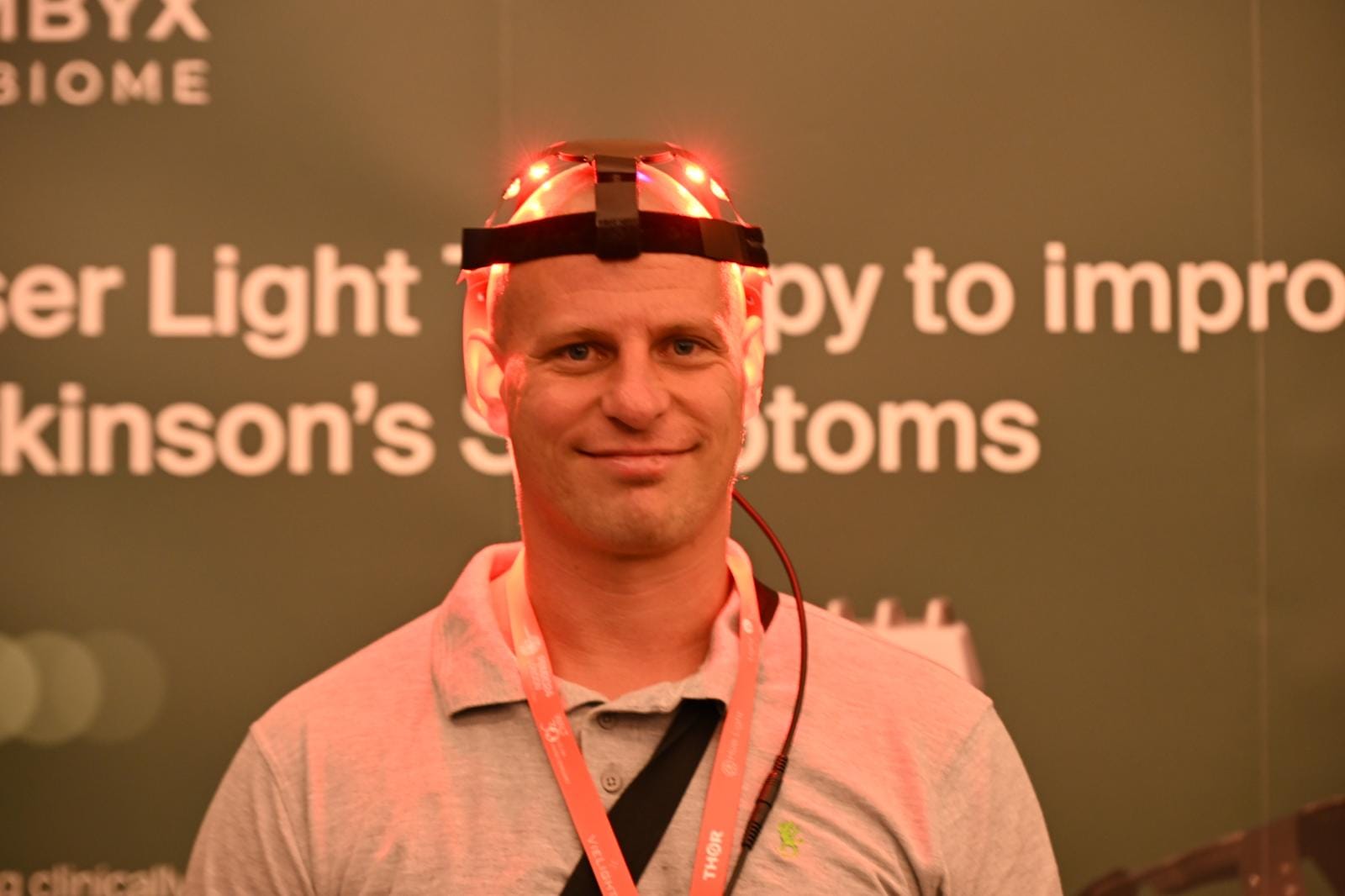
Also, there's more:
SYMBYX has listed quite a few studies on their website that I've read before interviewing the company's CEO, Wayne Markman (7; 8; 9; 10; 11; 12). The company is also engaged in further research with three studies listed on their ongoing research page.
Then there's the support team behind SYMBYX. You don't just buy a product, the company selling the product wants to ensure that the product works well for you. For that, the clinical team can help you adjust your treatment parameters so that you'll get results.
Initially, there's about a 60-70% satisfaction rate when using the products as prescribed. Of the 30% of customers that contact their clinical team, over 90% report being “satisfied” or “extremely satisfied”. Compared to other therapies, including pharmaceuticals, these numbers are truly impressive.
The brain-gut axis is hypothesized to play a significant role in the formation of Parkinson's Disease nowadays (17; 18; 19: 20). Gut problems increase the risk of Parkinson's Disease, and Parkinson's Disease massively increases the risk of gut problems.
In their manual, based on customer feedback and on published studies, SYMBYX mentions the following potential improvements for people with Parkinson's
Walking speed and gait
Movement skills and control
Cognition
Sense of smell
Balance
Fine motor dexterity
Pain and inflammation
Improved gut health.
These are based on the PDCare Laser. Right now, more than 7,000 people have benefited from the SYMBYX products. This dynamic translates into lots of that money is going back into research so that better products can be developed for not only Parkinson's disease but also other neurodegenerative diseases!
And, lastly, if you're a healthcare clinician, SYMBYX offers products for professionals as well.
4) 1,070 nm Is A Truly Special Wavelength
During the PBM 2024 conference, there was loads of discussion about the optimal wavelengths and the role of wavelengths in photobiomodulation. One topic I really want to zoom in on is the research of Professor Paul Chazot on the 1,070 nm range. With range, I mean that wavelengths such as 1,068 nm and 1,072 nm have (roughly) the same effect.
And, the reason this wavelength works so well is because it is located at the peak of the water absorption spectrum. In some theories that aren't universally accepted within science, water can assume a fourth phase next to its liquid, frozen, and gas states. In that crystalline fourth phase, water acts as a battery by holding charge and helps increase energy production. It is hypothesized that both red and near-infrared light exposure to the human body can induce this state. The theory was popularized by Gerald Pollack about 10 years ago (13; 14; 15; 16).
But back to Professor Paul Chazot. One theory he proposed during his talk is that structured water at 1,070nm (could happen as low as 1,064nm, so it's a range) would directly aid energy production in the mitochondria through ATP synthase. ATP synthase is the final step in the mitochondrial energy-production process. Here, photobiomodulation may decrease the viscosity of the water in the mitochondria so that ATP synthase can rotate faster. This process - if I interpret it correctly - would give you an additional mechanism to create energy, outside the regular membrane potential.
Chazot is doing some really interesting research with this wavelength precisely, such as:
- 1,068 nm may affect the heat shock proteins (which you also affect with cold therapy and saunas) and may therefore help counter COVID-19 (17). Chazot's research group writes that:
"Our findings illustrate the efficacy of PBMT 1068 nm for cytoprotection, nitric oxide (NO) release, inflammation changes, improved blood flow, and the regulation of heat shock proteins (Hsp70). " (17).
- The wavelength may improve your motor abilities, memory, and processing speed. Processing speed is an essential domain of IQ which measures how quick your brain is at tasks. This effect was achieved in healthy participants (18).
- 1,068 nm may help counter Alzheimer's Disease (19). The same is true for traumatic brain injury (TBI), with improvements in sleep and the condition becoming less severe (20).
- Chazot also presented some really impressive science on diabetic retinopathy and neuropathy in his slides.
- Other topics discussed concerning 1,072 nm are cell protection, memory enhancement in aged mice, neuroprotection in Alzheimer's and the reduction of beta-amyloid plaques that underlie Alzheimer's Disease, and the management of blood glucose. If you're hyperglycemic (have high blood sugar levels), then and I paraphrase:
1,068 nm will improve mitochondrial function, lower inflammatory cytokines ("messengers"), aid neuronal differentiation and plasticity, help dopamine release for better neuronal function, and most importantly, lower blood sugar levels while offering protection to the neurons and glia.
- Most of these 1,068 and 1,072 nm studies - or around those wavelengths - have been carried out in in vitro (literally meaning "in the glass") and animal studies though.
- If you're interested in more information then you can find the data below:
Again, if you want more information, check Professor Paul Chazot's research. But, the wavelength does lead me to a very much related topic:
5) Neuronic With Its 1,070 nm Helmet Is Funding More Research And Education
We've been very interested in the Neuronic Neuradiant 1,070 nm helmet (code ALEXF5 saves) since we came across it last year. Alex Fergus has done a preliminary review of this helmet, for instance, here:
The Neuradiant 1,070 nm helmet is really impressive and many people have gotten great results. But what's less well known is that Neuronic is funding lots of research with their helmet, with five specific studies. I'm copying the titles from their information sheet below:
- "Effects of PBM on Fatigue", by the BRAI3N Center
- "An investigation of Transcranial Magnetic Stimulation and Photobiomodulation on Major Depressive Disorder and Alzheimer's Disease" by the Delray Center for Brain Science
- "A Pragmatic, randomized, controlled trial to evaluate the effectiveness of a precision medicine treatment approach for early dementia and mild cognitive impairment" by the Maxwell Clinic, Tennessee
- "Investigation of PBM on Alzheimer's", institute N/A
- "RCT on Fatigue and the effects of PBM", institute N/A
Here, Neuronic offers many collaboration opportunities, such as:
- Limited funding for small trials such as pilot studies - if and only if they are well-designed.
- The loan and donation of devices, such as their helmet, for research.
- A discount on a device for a case study - so if you're a researcher and want carry out a case study with a Neuradiant 1070, you can contact them!
- Support with study design from Neuronic's team of experts.
Also, lately, Neuronic has offered a Masterclass. Alex has also participated in that class so far! Neuronic offers monthly discussions that are paired with their Masterclass.
6) Professor Michael Hamblin Offered Wonderful Insight On Dosing And Other Foundational Topics
So, Michael Hamblin was at the top of his game at PBM 2024! Now emeritus Professor Michael Hamlin gave some great commentary on many of the foundational discussions around photobiomodulation.
I've included the highlights of these discussions for you:
- First, concerning dosing, the "biphasic dose-response" is well-proven in mice and rats but not humans. The biphasic dose-response here means that some light is stimulating, more light is even more stimulating, but that there's a cutoff point where the benefits deteriorate and theoretically, you could even impede yourself.
- I've recently put out two blogs on the topic of dosing so my interst here was sky high. First I've put out a blog where I go through all the systematic reviews on dosing and show that suggested science-based dosing parameters vary wildly for different goals. Secondly, I wrote a blog on whether universal dosing parameters are viable in the first place based on that earlier data.
- A presentation by his PhD student and now an associate professor at Harvard, Paulo Cassano (MD), is an exception, which Prof Hamblin acknowledges. Cassano has shown a dose-response curve in Major Depressive Disorder. There the high dose group did worse than the lower and medium dose groups.
- According to Hamblin, the NOS (Nitric Oxide Synthase) mechanism has never been proven either. Here, the argument is that photobiomodulation liberates nitric oxide in the mitochondria so that energy production can increase.
- Exposure to light will give you days and, even in some instances, weeks of effects because of gene expression. Gene expression is the activation and deactivation of some parts of your DNA that can be influenced by things such as lifestyle and light exposure. For that reason, just one treatment can have huge effects on things such as depression.
- There's probably not a single mechanism through which photobiomodulation works. There are the roles of Opsins, such as OPN3, 4 and 5; there are "nanostructured" water (the structured water I talked about before); there are the changes in gene expression and the transcription factors that precede them; there are the effect of light on ion channels, and more. And, likely, many of these don't work in isolation but interact.
- Nobody fully understands photobiomodulation pulsing. We know something about the basics, such as the effects of 10 Hz or 40 Hz pulsing that can induce alpha and gamma brainwaves, respectively.
- Nevertheless, and I quote from the sheets, Prof Hamblin does conclude that "PBM mechanisms are becoming understood" - so there's optimism!
- In his talk on photobiomodulation for neurology, Hamblin emphasized many different applications, such as TBI, depression, anxiety, drug addiction, autism, ADHD, stroke, epilepsy, Gulf War Illness, and more. Some of these domains don't have a great evidence base in the published literature in my opinion, such as autism, stroke, and epilepsy, but Prof Hamblin seems very positive that good strides can be made in these domains!
- The scalp is perhaps a mechanism as to why photobiomodulation for the brain works so well. Lots of blood runs through the scalp that will likely reach the brain. Prof Hamblin is somewhat skeptical about whether lots of light can penetrate the skull directly. Remember that the scalp thesis is a hypothesis, though, and not proven with data currently.
- Concerning the scalp comment, an unknown person from the audience mentioned that she had great results with applying red light therapy through the mouth to reach the brain. That conclusion is interesting because Thor Lasers has come out with a Lollipop model in the last few years that has 41 LEDs. I would love to see some initial pilot studies with a few participants and the lollipop model compared to transcranial red light therapy devices to see what design has the best outcomes. Examples could be with cognitive performance in healthy participants but also people with Parkinson's disease or for stroke recovery in the cerebellum (both places are likely well-targeted by placing a device in the mouth, unlike the prefrontal cortex above your eyes!)
- For neurodegenerative diseases, we'd ideally have much longer studies. For instance, for something like Alzheimer's or Parkinson's disease, you'd follow study participants for many years in a perfect world. But, doing so is cost-prohibitive and the cost of a current shorter-term study already runs in the millions of USD, often. So funding is a big problem here. Hence, please tell all your billionaire friends to contribute to the research on this topic liberally!
- Prof Hamblin thinks it's very important to focus more on Brain-Derived Neurotrophic Factor (BDNF) in relation to neurodegenerative disease, in particular Alzheimer's and Parkinson's. There should also be more focus on the formation of synapses.
- With regards to why ultraviolet light is so helpful in the mountains, Professor Hamblin doesn't believe in the standard explanations of that the ultraviolet light is stronger higher up in the sky. Temperature is also not a good explanation, according to Hamblin. Instead, Professor Hamblin believes that the lower oxygen concentrations, in combination with the light exposure, create the "magic".
Also, Alex has a very interesting interview with Professor Hamblin coming up soon, on our YouTube channel, where he goes into related topics to the above! Here you can see a behind the scenes of Alex interviewing Prof Dr Hamblin:
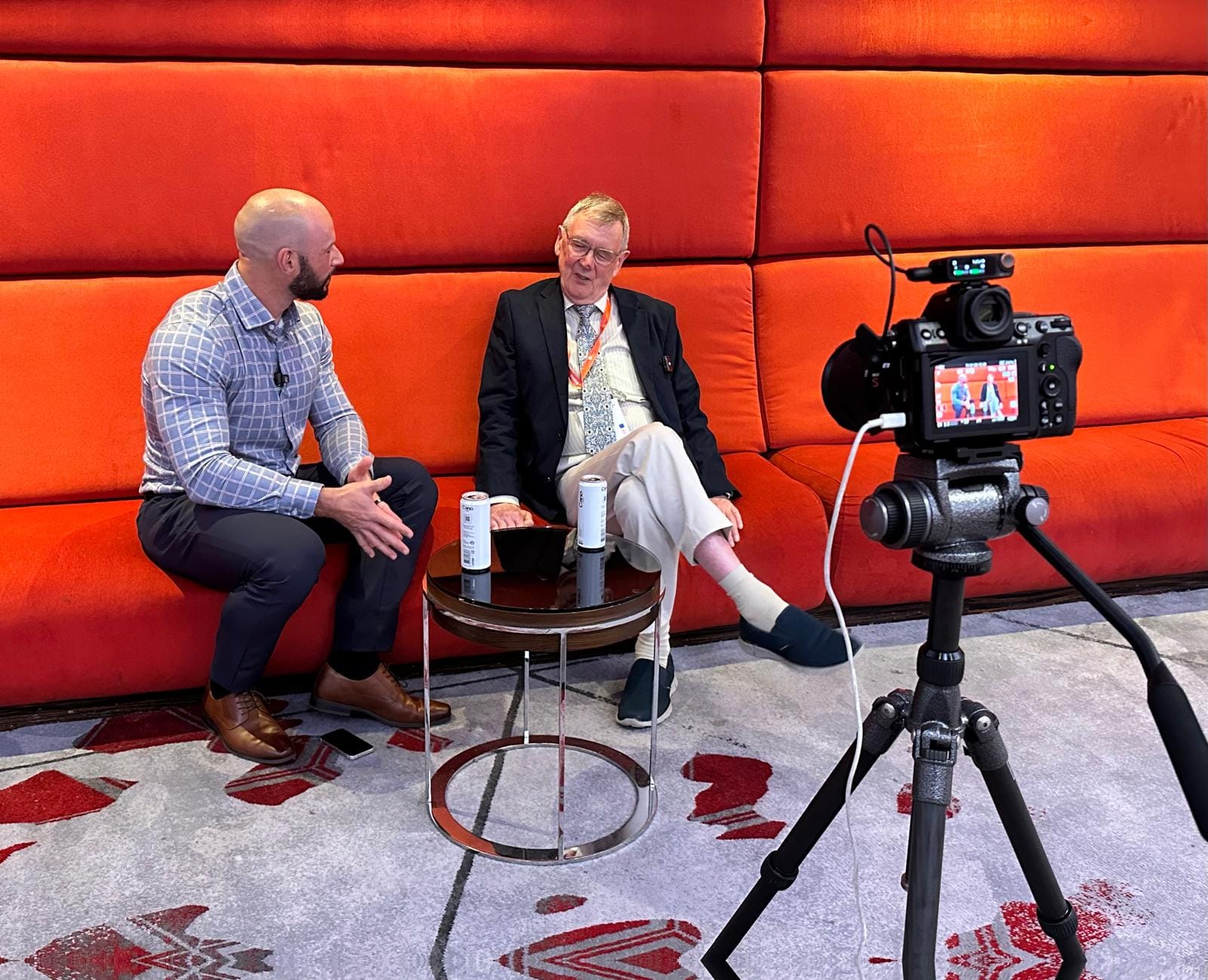
7) Both Alex And I Tried The NovoTHOR Bed For The First Time
Trying the NovoTHOR was quite the experience. And believe it or not, after all these years of working in red light therapy or photobiomodulation, I've never even tried a lying-down version of this therapy before!
So, what did I notice from trying the NovoTHOR for the first time? Here's a short list:
- Excellent energy levels - as if I'd just drank 3-4 cups of coffee, literally. At the moment of doing my NovoTHOR session, I hadn't had any coffee for a month or so (now, while writing this article I do!). Nevertheless, I felt super energetic after the NovoTHOR session. Remember that I had flown from Mexico to get to London, and I can never sleep on airplanes even though it's an overnight flight. The Thursday to Friday I did sleep perfectly in London, and the next day I had my NovoTHOR session. But I'd been without good light exposure for a few days then.
- Secondly, I'm getting a profound meditative effect from the NovoTHOR. It's not sleeping for sure, as I don't fall asleep. Still, I'm getting the feeling that stress is realeased in the same way you'd get with mantra meditation types such as Transcendental Meditation or Vedic Meditation. For me, stress release means some shaking near the upper thoracic and the lower cervical spines. I get these shakes during that meditation form almost always, and got the same during my time in the NovoTHOR. So, for some reason, there's very strong parasympathetic activation there - the "rest and digest" part of the autonomic nervous system!
- My vision improved immediately after the 20-minute session. Keep in mind that I'd been under blue light for about 48 hours by then, with tons of presentations and so forth. This could be placebo, as the other ones as well, but they are my experience. The world looked a bit sharper after my session.
- I had very slight hip and lower back pain from sitting on the plane during a transatlantic flight and then standing and walking all day at the conference. After the NovoTHOR session, that slight pain was gone.
That's it! I'm sure Alex will soon also showcase his experience with the NovoTHOR. Here's a picture of Alex in the NovoTHOR:
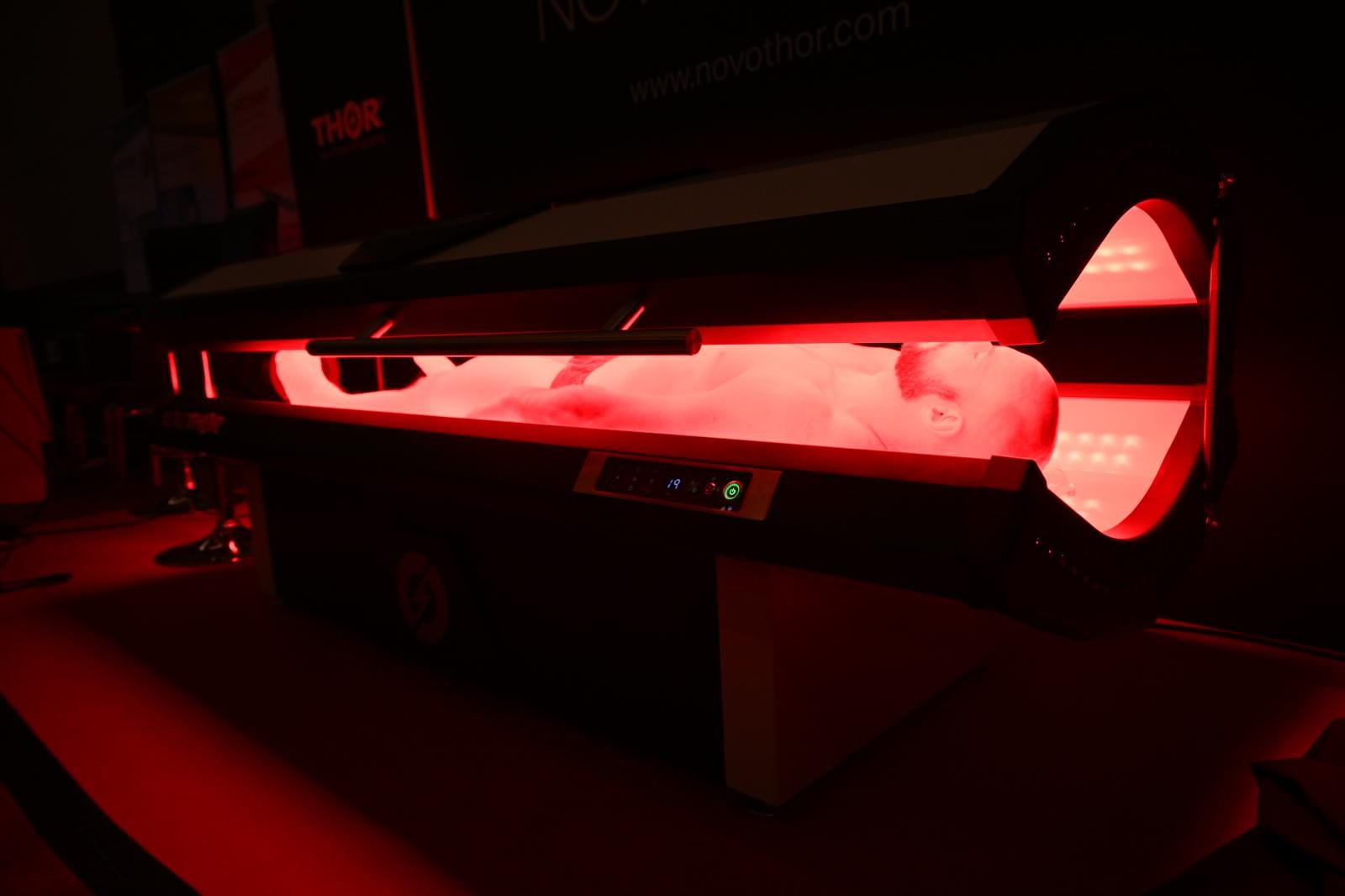
8) Lasers Are Heavily Defended (Perhaps Justifiably So) By A Few Companies
Many different companies offered lasers at the PBM 2024 conference. I'll go through these companies one by one and mention some things that I've learned from them:
- First up, there's PowerMedic Lasers. PowerMedic has been in business for a whopping 40+ years. I've talked to the founder and president of the company, Arne Grinsted, and Alex interviewed him too. Follow our YouTube channel if you'd like to listen to the Arne Grinsted interview. Interestingly enough, I saw a few products not listed on the PowerMedic website. This included the Fertilaser and the Hyperlaser. The first is a laser treating a more extensive body area, specifically for female fertility. Secondly, the Hyperlaser is an extremely powerful laser product whereby all the lasers aren't activated simultaneously. The Hyperlaser has the lasers pointing out of the device, so that the compression method of red light therapy can be optimally used. You'd push the lasers into the skin, so to speak, which allows for deeper penetration.
- I had a great talk with Arne Grinsted about some of the early work in the photobiomodulation space, such as that of Tina Karu. Karu was one of the earliest researchers to work on cytochrome C oxidase in relation to light therapy, and the excitation of electrons by light. Karu also claims that coherence - which lasers are because they emit one wavelength of light - lead to deeper penetration.
- The fertility treatment product of PowerMedic Lasers is aimed at the microbiome as well, which should also help fertility. If I remember correctly, the interesting anecdote here from Arne is that postmenopausal women were treated with photobiomodulation for the gut for some time. These women later regained their periods!
- Secondly, there's Summus Medical Lasers. Two gentlemen, Dr. Richard Albright and Phil Harrington explained their system to me. The benefit of these lasers aimed at medical professionals is that the method is "foolproof". You can select a body part on the display, then use the correct head on the laser for the given goal, and then you'll be shown how to move the laser around in the exact treatment area. The benefit is that the patient can see the doctor or nurse select the body part. Your personal characteristics, such as your skin type, influence that selection process. Also, because treatment is very much simplified, a nurse can often apply this treatment easily. If you want to, however, you can still modify your treatments. Also, the Summus Medical Lasers can deliver a lot of power as their strongest device goes up to 2 Watts.
- There were some other people who were vehemently pro-laser and mostly against LEDs. I'm taking more of a middle ground and think that both applications work wonderfully - I also think most consumers should opt for LED devices first because of the sheer light output coming from them - as Prof Michael Hamblin argued! The total amount of light coming from an LED is huge, while the total amount of light coming from lasers is tiny but is focused on a small area. Both have their benefits and downsides.
9) Alex Has Academic Competition! Professor Mark Cronshaw Tested Torches
You may know Alex's review of the LightpathLED Diesel Torch here:
Well, it turns out that Professor Mark Cronshaw from de Monfort University, Leicester, England, has done some independent testing of some Amazon torches by himself. And, he's not impressed I can tell you!
The title of Prof Cronshaw's talk was "A Pilot Study Of LED Home Use PBMT Devices: Design, Function, And Potential". I can't find the study online yet, so it's probably not published yet, or it may not be published at all.
But let's consider the meat and potatoes of the lecture! Prof Cronshaw had patients coming to him, asking whether these devices from Amazon would do any good. He told his patients he didn't know and started to do some testing according to the scientific method. Here, not only the efficacy of the device mattered, but also the safety and the potential for professional applications.
Professor Cronshaw tested five different devices that had really high ratings on Amazon. He then used his professional lab equipment at the university to test these devices. The metrics that were tested - I'm quoting these directly from the sheets:
Wavelengths
Spot size & beam divergence angle
Power
Modes (CW/gated)
Irradiance (W/cm2)
Radiant exposure (J/cm2)
[Delta in Temperature in degrees Celsius]
Attachments and accessories
Applications
CE/FDA?
Instructions to consumer (score 0-5)
Consumer feedback
So here's some data from the sheets that I've written out:
All the handheld torches that were tested had evidence of recent sales. All of the torches emitted 660 and 850 nm, but many also emitted multiple wavelengths. The power output of these devices was very high, ranging from 100 mW/cm2 to a whopping 600 mW/cm2.
Some of the torches used pulsing. Three devices supplied glasses, but these glasses don't block most red and NIR. The devices would be advertized for many different things, such as pain, myalgia, TMD, ulcers, herpes, tendonitis, arthritis, acne, and more. The beam angle in most of these devices was 74 degrees, although one device had a beam angle of 28 degrees. In some cases, there were red flags as one manual stated not to turn on the torch for more than 5 minutes (I'll come back why in a second!).
Now here's an interesting thing: the power output of these devices wouldn't even stay the same over time. After one minute of use, there would be a huge dropoff in power output in the most powerful devices. That dropoff continued until the three-minute mark was reached. Two out of five devices had this problem. Power output was more than halved in these cases.
Also, some treatment manuals recommended a frequency of two to three times per day, under which many people would likely overdose. Treatment times in these instances would be five to ten minutes per session even (please keep in mind that the power output of these devices is also very high!). And some of these devices overheated too, to dangerous levels.
So what's Professor Cronshaw's conclusion? These Amazon products don't live up to the standard you'd want medical equipment to have. Sure, there may be benefits to these devices. Still, it's a loose cannon that even Professor Cronshaw cannot control, let alone the average person buying from Amazon without background knowledge in photobiomodulation.
Please remember that Professor Cronshaw has repeatedly said he's open to such consumer products being used, just not when they are unpredictable. And, for that very reason, he cannot recommend these five torches to his patients either, as it creates medical liability if something were to go wrong. Instruction manuals aren't even correct in this case.
And, what's also interesting is that Professor Cronshaw does think clinical trials need to be carried out with better consumer products. I hope to see more of his research in the future for sure!
10) Much Photobiomodulation Research Is Problematic - Professor Steven Parker
So this problem has been alluded to before in our work on this website. James Carroll talked about the problem with photobiomodulation science in the following interview:
Some of the problems in photobiomodulation science are that:
- Many of the key metrics, such as the treatment area or the total dose in J/cm2 aren't reported in the published literature.
- Scientists don't have the proper measurement tools or don't use them before publishing a study.
- And because key metrics aren't reported in photobiomodulation studies, the outcome of studies is either hard to replicate or even meaningless in the worst-case scenario.
Professor Steven Parker made similar arguments in his speech during PBM 2024. Simply put, the academic environment and associated industry need to be standardized and professionalized so that published research offers better value.
Professor Parker carried out a systematic review together with Prof Cronshaw about common dental practices - which I talked about earlier. I can't find the published study online yet but it will come out in 2024.
In that systematic review - which analyzes and integrates previous individual studies in a domain - Prof Parker included topics such as temporomandibular joint dysfunction (the jaw joint), the surgical removal of wisdom teeth, and orthodontic treatments.
Initially, Prof Parker found just under 15,000 studies on the topics. After the selection process in a systematic review, that number shrank to 53 studies in total included. There were a few inclusion criteria for this process, such as a minimum of 10 study participants per arm of the study, and the inclusion of Randomized Controlled Trials (which have a placebo and intervention group).
The problem in analyzing these studies - just like James Carroll mentioned - is that key metrics are missing. Here, you can think about whether there's pulsing used or not, the beam angle, the total dose in Joules/cm2, the total area in cm2 that's being treated, the peak and average power, and more!
Without those numbers, studies are hard to interpret because there's a divergence in how the data can be interpreted. If you're curious, though, you can check some of Prof Parker's earlier work, as well as that of his colleagues (21; 22; 23; 24).
11) Photobiomodulation For Eye Health With Dr. Clark Tedford
So Alex and I recently published an interview wherein I went through all of the literature on red light therapy for eye health - that you can view here:
What's interesting is that during PBM 2024, Dr Clark Tedford held a speech called "Photobiomodulation In Opthalmology: Development Of The Multiwavelength Valeda Light Delivery System For Treatment Of Degenerative Ocular Disease". Dr Tedford is associated with LumiThera, a company that has developed light therapy devices for eye health.
You can see the Valeda light therapy device for eye health being used here:

But, the most crucial thing regarding Dr Tedford's speech is that it allowed me to fact-check my interpretation of the data. Fortunately, we aligned in our interpretation, so I was pretty happy with that.
Dr Tedford is a co-founder of LumiThera and they've been around for 10+ years now. And the good thing for both of us is that the amount of research on photobiomodulation for ophthalmology is exploding - with 200+ papers available now!
(If you're curious, check out my blog on photobiomodulation for eye health!)
Now, Dr Tedford explained why photobiomodulation is so vital for eye health. Here's my recap of that speech in my own words:
First up, the retina at the back of the eye (like the screen that the projector (lens) projects onto) is very metabolically active and is the highest oxygen-consuming part of the human body. The retina relies on mitochondria to function.
And you probably know that mitochondrial function is one of the main, if not the main, mechanisms by which photobiomodulation affects health. Nevertheless, aging and oxidative stress inhibit mitochondrial function, thereby causing eye problems over time. Repair mechanisms are inhibited, and antioxidant status deteriorates with age.
As a result, the health of the retinal cells goes down. Other eye diseases are affected by mitochondrial function and oxidative stress as well, such as hereditary diseases, glaucoma, age-related macular degeneration, diabetic retinopathy, and methane toxicity. The combination of oxidative stress and mitochondrial dysfunction eventually leads to cell death in the eye.
Now, the Valeda device of the image above uses three different wavelengths: 590, 660, and 850 nm. All of these have slightly different effects, and I quote directly here:
590 nm - Cellular Targets: Stimulates COO activity, increases nitric oxide (NO) synthesis, inhibits VEGF expression. Secondary Effects: Vasodilation, improves local O2 and nutrient delivery, VEGF reduction.
660 nm - Cellular Targets: Promotes O2 binding to COO active CuB/Fe23 site. Secondary Effects: Upregulates Electron Transport Pathway. Increases energy (ATP) production. Reductes inflammation and cell death.
850 nm - Cellular Targets: Drives electron transfer at Cu site of COO. Secondary Effects: Upregulates Electron Transport Pathway. Increases energy (ATP). Reduces inflammation and cell death.
So that sounds perfect!
With the Valeda system, light output is mostly in the red part of the spectrum,, at 65 mW/cm2. At 590 nm, the power output is 5 mW/cm2 and at 850 nm, the power output is 8 mW/cm2. The beam angle is 30 degrees.
The light alternates between 35 seconds of the 590 nm amber light is pulsed for 90 seconds and then a 90-second period of red and NIR. That cycle is repeated twice. Patient's testimonies have been excellent using this protocol.
Overall, the future of red light therapy for eye health looks super bright! The only comment I have here is that tons and tons of different protocols haven't been tested for in photobiomodulation for ophthalmology.
So, you don't know if something works or not without testing. Maybe 15 minutes of NIR at 810 nm is far superior to the protocol above, but we don't know without doing at least a pilot study. In the same way, I could think of 20+ different protocols that can be tested for eye health that haven't been tried in the literature.
I also think that people sitting indoors 90%+ of the day is probably one of the worst things you can do for eye health. Sunlight provides a far stronger input than the Veleda device I've listed above, as sunlight can approximate 100 mW/cm2+ with high-energy blue and ultraviolet. And, people will spend hours a day with some indirect exposure to full-spectrum light if they're working outdoors, for instance. So, the protocol above is pretty conservative, just like mine is!
Next up:
12) Improving Facial And Dental Health And Aesthetics With Dr. Ana Paula Tanko, An Oral Surgeon
First up, a little disclaimer: since last weekend at PBM 2024 I know Dr. Ana Paula Tanko personally. But, I, including her, has nothing to do with knowing her and is based upon merit alone.
Dr. Ana Paula Tanko is a dental surgeon who had the best presentations at PBM 2024 by a long shot. The reason for this was excellent case studies of herself and her patients, where she mapped the entire clinical process. I can't include these pictures in my blog due to privacy concerns, but I can explain the process in more detail.
Dr. Tanko's specializations, besides dentistry and oral surgery, include orofacial therapy, orthodontics, and laser therapy, which guides the entire process. Seeing the results she has achieved for herself was truly impressive, with a combination of oral surgery, orofacial therapy, laser therapy, and more.
Many people would be interested in this dynamic for anti-aging purposes alone, but the process goes further than that and includes health reasons as well. For instance, making adjustments to the jaw or teeth can help you nasal breathe better. Some people are naturally mouth breathers because of their facial structure that doesn't allow for proper tongue position.
But what is "orofacial therapy" or "orofacial harmonization"? This is a new specialty in Brazilian dentistry that combines the teeth, lips, and face both individually and taken together for both functional balance and aesthetics. Photobiomodulation is used during all of these procedures, many of which involve surgery.
One of the main targets of photobiomodulation here is avoiding infections. Sometimes, after surgery, despite antibiotics, anti-inflammatory drugs, and painkillers, patients don't heal properly, and then photobiomodulation is indicated. Photodynamic therapy (PBT) may also be combined with methylene blue in case of an infection or the risk thereof.
Dr. Ana Tanko also uses intravenous light therapy, such as red, green, and blue light, with all of her patients who undergo surgery or who enter the dentist or oral surgeon's office.
Also, many aesthetic problems aren't aesthetic problems alone. For instance, if you don't have a good bite or don't have a good jaw or facial structure, it won't just affect your appearance but also your chewing function. And, chewing function will affect your overall health again.
During the orofacial treatments, different types of light therapy are applied. Blue LED light, for instance, is applied for moisturizing and clearing the skin, according to Dr. Ana Paula Tanko. Amber LEDs are used for collagen and red lasers to reduce inflammation.
For the classical Brazilian, almost nothing goes too far to improve both appearance and function. I've lived in Rio de Janeiro myself for almost three months, so I'm somewhat familiar with the culture and Brazil's differences with other LatAm countries!
The result, for people who combine oral surgery, orofacial therapy, photobiomodulation, and more, is improved beauty, self-esteem, and health. So, orofacial therapy is "biohacking" for your dentistry, jaw, face, and any related areas to improve both function and aesthetics.
Lastly, I want to thank Dr. Ana Paula Tanko for our wonderful time together and her explanations of her philosophy on dentistry in person to me. If you've got any questions, you can best reach out to Dr. Tanko on her Professional Instagram.
Paw wounds apparantly are very common, especially in rescue dogs. Many different reasons exist for these wounds, such as traumas, infections, burns, dehydration, and more.
Dog Bravo had undergone three unsuccessful surgeries over four years. Bravo likely was six years old during the case study. There paw was inflamed and had an open wound, with exposure of the muscle tissue. The pad of the paw was dehydrated and cracking. For humans, that's similar to having an open wound in the palm of your hand - while needing to use that hand every day.
Dr. Paula Tanko cleaned the wound with soap, water, paper towels and hydrogen peroxide. She then used a 0.01% solution of methylene blue at the wound, and used a 30 J/cm2 red and NIR laser at the wound over 300 seconds. Gauze was applied then and the paw was taped. This treatment was repeated three times per week.
There was good improvement after just one session of this Photodynamic Therapy (PDT). But, the wound remained open and surgery was required again. The area was cleaned during surgery, and a similar PDT protocol was used again. The dog had a cavity in the paw, and fiber optics were used to guide the laser therapy inside the paw.
After four months, the paw was completely healed. And, best of all, Bravo is happy and healthy today, and has been adopted by Dr. Paula Tanko!
Lastly, let's consider a few other ideas and innovations I got from PBM 2024:
13) Assorted PBM 2024 Ideas And Lessons
So, just a few comments before I conclude about the event:
- First, if you're not mentioned, I'm very sorry, but I had to make choices and can't cover everyone. One of the big problems here is that the PBM 2024 lectures aren't recorded, and often, you'd have to choose between 3-4 different topics. I've chosen for the topics that I thought would adhere to our audience the best and the discussions we've been having in our Facebook Group.
- I hope at PBM 2026, we can get recordings, perhaps with privacy-sensitive patient information cut out of them. Something is better than nothing here!
- Secondly, I want to thank everyone for the great time. I've met some of the people I've been reading from for many years now, such as Prof Michael Hamblin. Alex even interviewed Hamblin which will be extremely interesting! Some other mentions are the genius Aaron Rogers working for Kineon and the great hospitality shown by James Carroll for inviting our entire team to their Thor Photomedicine table at the black tie event! If you're interested, here's one more picture of Alex and I before the event:
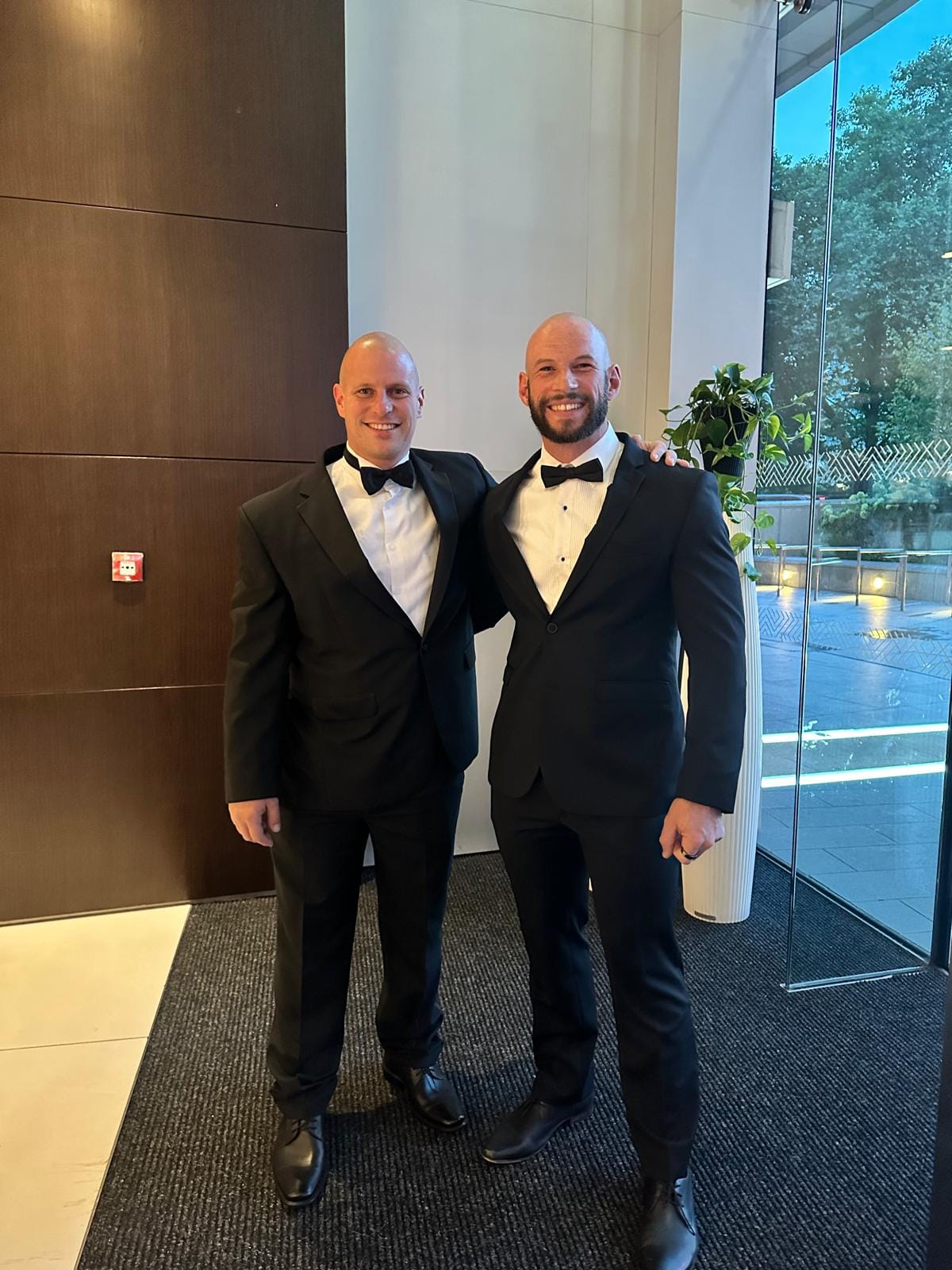
- I've learned a lot. I also think that this process isn't going to be easy and a lot will be discovered in the coming decades about photobiomodulation. I also believe that lots of things that we currently hold true, will be either fully incorrect or not entirely true and that 50 or 100 years from now, the industry and the science on this topic look really different. I may be wrong here though!
- There are many new red light therapy bed companies on the market. One example here is the Prism Light Pod, that claims a power output of a whopping 100 mW/cm. The Prism also combines lasers for the red part of the spectrum and LEDs for near-infrared. And, there are 17,000 LEDs in the Prism Light Pod! And if the Pod is too expensive for you, Prism also offers a whole-body wrap! Check out the Prism Light Pod here, though:

- Next up, there's the Hue Light Whole Body Photobiomodulation chamber. The Hue Light Chamber isn't just another red light therapy bed but incorporates the Nogier Frequencies for pulsing. I'm skeptical about these frequencies until I see good data that they work, but I'm open-minded that they can work. Hue Light does have a very good table on the topic - if you click "Nogier Frequencies User Guide" on THIS page. The Hue Light is pricier, coming in at around $110,000 USD. And, the bed also emits green light, going as low as 540 nm. You can see the Hue Light Whole-Body Photobiomodulation Chamber here:

- Prof Jan M. Bjordal made the case that even though there's tons of evidence available for photobiomodulation, with RCTs and reviews on given topics, these rarely translate into medical guidelines changing. Often, PBM will work just as well as pain medication, for instance, but the recommendation frequently focuses on pain medication and does not recommend PBM to patients. Prof Borjdal explained that phenomenon through the absence of knowledge about the industry by general medical practitioners, as well as conflicts of interest.
- Alex has a whopping eight interviews upcoming with different people from the event. You can watch these interviews soon on our YouTube channel.
- I also conducted my first two interviews with Wayne Markman from SYMBYX Biome and Dr Thomas Breuneval from Switzerland. The first I've already introduced, but the latter deserves his own five minutes of fame:
- Dr Thomas Breuneval worked as a radiation oncologist and was the head of his department in Switzerland. After seeing the effects of photobiomodulation with his own eyes, he not only gave up his career but also sold his own house, as I understand it, to start his photobiomodulation clinic. Right now, Dr Breuneval uses photobiomodulation to counter the side effects of cancer treatment but also for athletes and gender-specific care - with a heavy emphasis on female health! You can find his clinic, the PBM Center Center, in Montreux Switzerland online HERE. Thomas has the latest photobiomodulation tools, such as the NovoTHOR bed and the Thor Laser setup for spot treatment, among others.
- The PBM 2024 conference was extremely busy, and it was impossible to view all of the lectures and to talk extensively to all business owners presenting their products,. There were a few things I'd loved to have explored, such as lectures and products, but there wasn't enough time! Fortunately, Alex has done a deep dive into some of these topics I've missed, so we should be good! I've missed a few things, such as Vielight - Alex interviewed them and that interview should be out in the next few months on our YouTube channel:
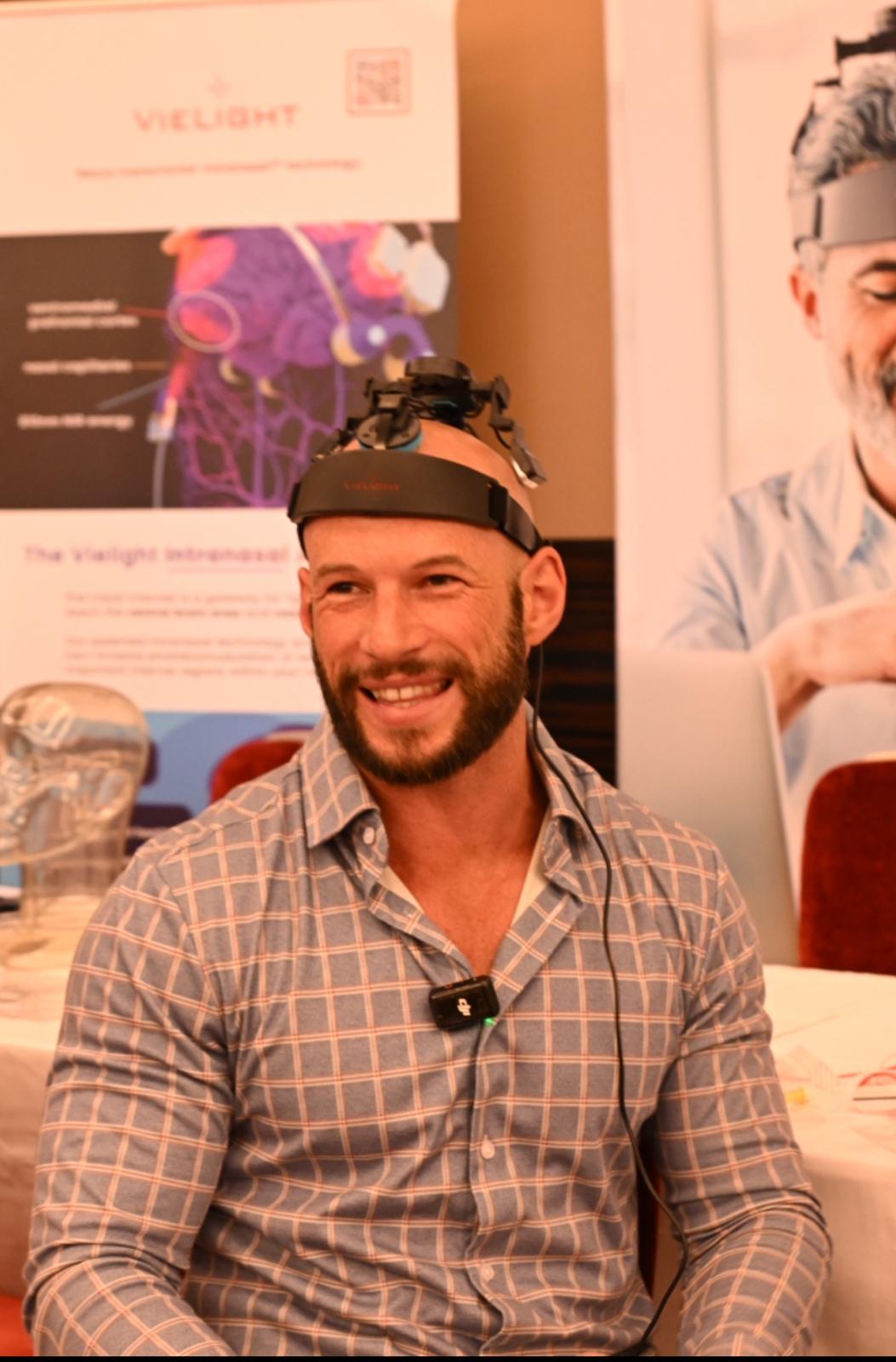
Conclusion: PBM 2026 - Here We Come!
I can't wait until PBM 2026 - whatever location on this planet that conference may be held. And I hope to see many people I saw at PBM 2024 again there. Hopefully, by then, I've also accumulated a lot more experience in the photobiomodulation space to interview some of the scientists in the field.
The scientists drive this field forward even though that's rarely acknowledged. I rely on the hard work of these scientists every day when writing my articles. So I want to thank you all for the wonderful work you do!
Nevertheless, as you can see from the information I've provided above, PBM 2024 was a kind of tour de force. I've learned a ton, and hopefully, my lessons - the newest ideas and innovations - also reach you and help you improve your life! And, hopefully, I'll see you - the reader - also during PBM 2026! It's sad in a way that it will take 2 years for the next event to occur...
Found This Interesting? Then You Might Like:
- Start Here - Light Therapy 101 & Buyers Guide
- Discount Codes, Deals & Recommendations - Red Light Therapy
- Red Light Therapy For Upgrading Your Brain Health
- Thor Laser Photobiomodulation Course: 16 Amazing Lessons Learnt
- Red Light Therapy For Weight Loss: The Science Of Supercharging Fat Loss
- Red Light Therapy For Sleep: The Science of Sweet Dreams
- The Effectiveness Of Light Therapy For Sleep Disorders
This is a post by Bart Wolbers of Lighttherapyinsiders. Bart finished degrees in Physical Therapy (B), Philosophy (BA and MA), Philosophy of Science and Technology (MS - with distinction), and Clinical Health Science (MS), has had training in functional medicine, and is currently chief science writer.
